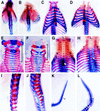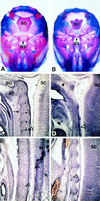The mouse bagpipe gene controls development of axial skeleton, skull, and spleen
- PMID: 10449756
- PMCID: PMC22272
- DOI: 10.1073/pnas.96.17.9695
The mouse bagpipe gene controls development of axial skeleton, skull, and spleen
Abstract
The mouse Bapx1 gene is homologous to the Drosophila homeobox containing bagpipe (bap) gene. A shared characteristic of the genes in these two organisms is expression in gut mesoderm. In Drosophila, bap functions to specify the formation of the musculature of the midgut. To determine the function of the mammalian cognate, we targeted a mutation into the Bapx1 locus. Bapx1, similar to Drosophila, does have a conspicuous role in gut mesoderm; however, this appears to be restricted to development of the spleen. In addition, Bapx1 has a major role in the development of the axial skeleton. Loss of Bapx1 affects the distribution of sclerotomal cells, markedly reducing the number that appear ventromedially around the notochord. Subsequently, the structures in the midaxial region, the intervertebral discs, and centra of the vertebral bodies, fail to form. Abnormalities are also found in those bones of the basal skull (basioccipital and basisphenoid bones) associated with the notochord. We postulate that Bapx1 confers the capacity of cells to interact with the notochord, effecting inductive interactions essential for development of the vertebral column and chondrocranium.
Figures





Similar articles
-
The role of Bapx1 (Nkx3.2) in the development and evolution of the axial skeleton.J Anat. 2001 Jul-Aug;199(Pt 1-2):181-7. doi: 10.1046/j.1469-7580.2001.19910181.x. J Anat. 2001. PMID: 11523821 Free PMC article. Review.
-
The murine Bapx1 homeobox gene plays a critical role in embryonic development of the axial skeleton and spleen.Development. 1999 Dec;126(24):5699-711. doi: 10.1242/dev.126.24.5699. Development. 1999. PMID: 10572046
-
Bapx1: an evolutionary conserved homologue of the Drosophila bagpipe homeobox gene is expressed in splanchnic mesoderm and the embryonic skeleton.Mech Dev. 1997 Jul;65(1-2):145-62. doi: 10.1016/s0925-4773(97)00067-1. Mech Dev. 1997. PMID: 9256352
-
Transcription factors Nkx3.1 and Nkx3.2 (Bapx1) play an overlapping role in sclerotomal development of the mouse.Mech Dev. 2002 Sep;117(1-2):217-24. doi: 10.1016/s0925-4773(02)00207-1. Mech Dev. 2002. PMID: 12204261
-
MHox and vertebrate skeletogenesis: the long and the short of it.Bioessays. 1995 Sep;17(9):750-3. doi: 10.1002/bies.950170903. Bioessays. 1995. PMID: 8763826 Review.
Cited by
-
The role of Bapx1 (Nkx3.2) in the development and evolution of the axial skeleton.J Anat. 2001 Jul-Aug;199(Pt 1-2):181-7. doi: 10.1046/j.1469-7580.2001.19910181.x. J Anat. 2001. PMID: 11523821 Free PMC article. Review.
-
Hedgehog signaling is required for formation of the notochord sheath and patterning of nuclei pulposi within the intervertebral discs.Proc Natl Acad Sci U S A. 2011 Jun 7;108(23):9484-9. doi: 10.1073/pnas.1007566108. Epub 2011 May 23. Proc Natl Acad Sci U S A. 2011. PMID: 21606373 Free PMC article.
-
Nkx2-3-A Slippery Slope From Development Through Inflammation Toward Hematopoietic Malignancies.Biomark Insights. 2018 Feb 6;13:1177271918757480. doi: 10.1177/1177271918757480. eCollection 2018. Biomark Insights. 2018. PMID: 29449776 Free PMC article. Review.
-
Functional Duality of Chondrocyte Hypertrophy and Biomedical Application Trends in Osteoarthritis.Pharmaceutics. 2021 Jul 26;13(8):1139. doi: 10.3390/pharmaceutics13081139. Pharmaceutics. 2021. PMID: 34452101 Free PMC article. Review.
-
Congenital asplenia in mice and humans with mutations in a Pbx/Nkx2-5/p15 module.Dev Cell. 2012 May 15;22(5):913-26. doi: 10.1016/j.devcel.2012.02.009. Epub 2012 May 3. Dev Cell. 2012. PMID: 22560297 Free PMC article.
References
MeSH terms
Substances
LinkOut - more resources
Full Text Sources
Molecular Biology Databases
Research Materials

